David Meerman Scott's Blog, page 61
August 25, 2014
Sales is broken
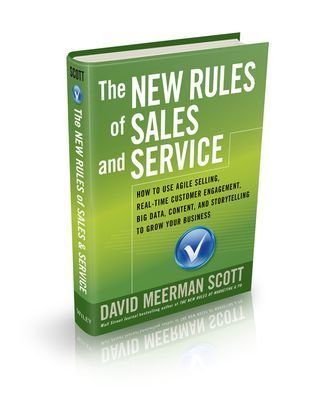 Most sales organizations are built and run as if it were still 1989. The sales model is broken.
Most sales organizations are built and run as if it were still 1989. The sales model is broken.
From 2004 through 2014 it has been a decade of the rise of Inbound Marketing.
Now, from today through 2024 will be the rise of Inbound Sales.
Early in my career, I worked as a sales representative at a Wall Street economic consultancy. Back then the salesperson had the information and therefore the power in the relationship.
If the buyers wanted information about how the product worked, they needed to come to me. If they wanted to negotiate a discount, they had to come through me. If they wanted to speak to a customer to learn about their experience with my company, they had to come through me. If they wanted to talk to the founder of the company, they had to come through me. I was involved from the very beginning of the relationship, and most of the leverage was with me, the sales rep.
That's how most sales organizations still operate.
But now, because of the wealth of information on the web, the salesperson no longer controls the relationship.
Now, the buyers can check you out themselves. They can find your customers and read their blog accounts about what you do. They can reach the founders directly via Twitter and LinkedIn. Buyers actively go around salespeople until the last possible moment and then come into negotiations armed with lots and lots of information. Now it’s the buyers who have the leverage.
Sales needs to change in order to be successful in this new world.
I wrote about this in my newest book titled The New Rules of Sales and Service: How to Use Agile Selling, Real-Time Customer Engagement, Big Data, Content, and Storytelling to Grow Your Business which is available now via ebook formats like Kindle and releases September 2 in print and audio.
August 21, 2014
The New Rules of Sales and Service - my new book - releasing soon!
I’m so excited I might pee in my pants!! (Don’t worry, I’ll be careful not to.)
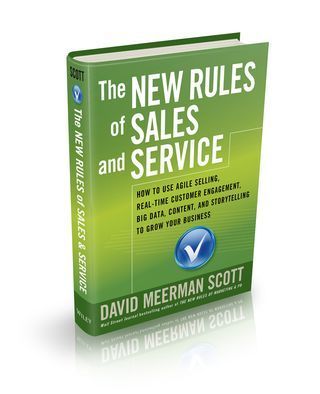 My new book, The New Rules of Sales and Service: How to Use Agile Selling, Real-Time Customer Engagement, Big Data, Content, and Storytelling to Grow Your Business is nearly ready to ship.
My new book, The New Rules of Sales and Service: How to Use Agile Selling, Real-Time Customer Engagement, Big Data, Content, and Storytelling to Grow Your Business is nearly ready to ship.
The New Rules of Sales and Service is about how the buying process has radically changed and how people who understand that change can grow business now.
Buyers are now in possession of unlimited information so online content is quickly becoming the dominant driver for commerce. Unfortunately most organizations are still using traditional selling and service models developed for a different time.
Release date
It’s looking like books will be ship from USA online retailers and be stocked on shelves at physical bookstores on September 2. Outside the USA will take a bit longer.
We’re aiming to have the electronic editions including Amazon Kindle and Apple iBook as well as the audiobook version from Audible available on the same day. (I read the audiobook version myself!)
Speaking and Webinar offer
To launch The New Rules of Sales and Service by getting some books into the market upon release, I am offering a one-time special for organization ordering multiple copies of the hardcover book. I’ve worked out substantial discounts from the $28.00 retail price for multiple copies from several USA retailers.
If you buy 100 or more books, I’ll do a free webinar or similar virtual event for your employees or clients. I normally charge $5,000 for a virtual appearance. You’d need to buy the books by the September 5, 2014 and do the virtual event by the end of 2015. Contact me for details.
If you book me by September 5, 2014 for a live speaking engagement at an event anytime in 2014 or 2015, I’ll provide up to $5,000 credit on my speaking fee for books that you purchase by September 5. (If you buy $5,000 in books, I knock of $5,000 of my speaking fee.) Contact me for details.
Pre-order the book now!
So you can get your copy as soon as possible, now is the time to pre-order your copy.
Here are some links to USA sites to order. Note that some direct links to the NRSS book page such as those from Nook and Audible aren’t yet live.
NRSS on Amazon
NRSS on Barnes & Noble
NRSS as a Kindle ebook
NRSS as an Apple iBook
NRSS from 800ceoread
NRSS via Books-a-Million
I’ll be sharing much more about The New Rules of Sales and Service over the next few weeks. Thanks for your interest.
August 19, 2014
Are you telling the truth?
When I see people on the sidewalk asking for money, most have the same business model.
They have a hand drawn cardboard advertisement that reads:
Homeless Veteran
Family man
Please help
GOD BLESS!!
I always wonder if they really are homeless, really are veterans, and really do have a family. I cynically doubt that the sign they hold is true.
 On the Las Vegas strip Saturday night, I ran into this gentleman and laughed out loud at his sign. I gave him some money and thanked him for the laughter.
On the Las Vegas strip Saturday night, I ran into this gentleman and laughed out loud at his sign. I gave him some money and thanked him for the laughter.
He told me that some people have a sense of humor and some don’t. He likes reaching those, like me, who get it.
This sign was especially funny to me because it is so obviously untrue but it makes me think of his competitors’ statements that they are homeless veterans with a family.
Is it the truth?
Here are a few other statements that I frequently see that I simply don’t believe anymore.
- Your call is important to us.
- Due to higher than expected call volume, your wait time is longer than normal.
- We love our customers.
- This is the best price I can offer.
Are you telling the truth?
August 15, 2014
It’s still great marketing. Just don’t call it a blog.
Because blogging isn’t new and hip, many people dismiss this form of content as less effective. Some are even abandoning their blogs for the next big thing (whatever that is).
I started my blog ten years ago (that’s seventy dog internet years).
Chris Brogan began blogging (when it was called journaling) well before I did. And when I worked on Wall Street in the 1980s for Wrightson ICAP, a real-time economic research firm, Lou Crandall was blogging there (doing his syndicated real-time market forecasts through an old black and white video technology called Telerate). Lou Crandall has been blogging in real-time for nearly thirty years!
So yeah, blogging has been around a long time. But that doesn’t mean it isn’t effective.
Blogging is my front door.
My blog is the most important free content I deliver, more important than Twitter, Facebook, LinkedIn, Google Plus, YouTube, Instagram, and the others I dabble in.
I get fantastic search engine optimization from my blog. I get sales leads from my blog. I reach the media with my blog. (I’ve met many of you through my blog.)
Blogging is a great front door for any individual or organization because it is real estate that you can own. If you use a content tool like HubSpot or WordPress and have your own domain URL, your blog is yours.
Contrast that with social networks like Twitter, LinkedIn, Facebook, and G+. All are good, but you will never own your real estate there.
I think the reason people seem to dismiss blogs these days might be because the term "blog" has a dated connotation. It seems old fashioned. Kids don’t blog. Kids are on Tumblr. (Of course, Tumblr is a blog platform too, but don’t tell the kids.)
Don't call your blog a blog!
Here’s an idea to get you over the aversion to the dated connotation of a blog. Call your blog something else!
I don’t know, maybe call it your “content site.” Or your “market commentary.” Or your "information hub" or something like that instead. It will help you get over the dated aspects of that “blog” word.
August 12, 2014
Giving things away for free to build your network and grow your business
At the Gathering of the Vibes music festival last weekend, besides the great live bands, I particularly enjoyed wondering around the camping area. It's fun to encounter interesting people who are part of the same tribe!
 On Saturday morning, I saw a bunch of tie-dye shirts and figured that somebody was selling them. Tie-dye is very popular at Vibes. As I paused, I was told they are free. Now, that’s interesting!
On Saturday morning, I saw a bunch of tie-dye shirts and figured that somebody was selling them. Tie-dye is very popular at Vibes. As I paused, I was told they are free. Now, that’s interesting!
So I got to chatting with Dave, the guy who made them. Dave told me he loves to make the shirts and giving them away brings back much more to him than money ever could.
By giving away free tie-dye shirts, Dave meets interesting people. By giving away free tie-dye shirts, Dave has initiates conversations. By giving away free tie-dye shirts, Dave gets gifts in return. By giving away free tie-dye shirts, Dave gives back to the community.
Although the shirts really are free and if you simply walk away with one, Dave’s cool, some people ask what they can do for him. He always suggests making a donation to the Vibes Food Drive.
I picked out a purple and blue shirt (with a pocket)! I took the shirt and told Dave I’d be right back. I went to my campsite, grabbed a copy of my book (written with HubSpot CEO Brian Halligan) Marketing Lessons from the Grateful Dead, returned and gave the book to Dave. It was a great trade.
Giving away content
In the online world, it is so easy to give away content! (Much easier than tie-dye shirts). You can offer videos, an ebook, a white paper, a deck on Slideshare, an infographic.
I suggest offering these things completely for free the way Dave does with his tie-dye shirts. Don’t require registration. Just give it away.
Sure some people will just take. But others will share the love with their friends, colleagues, and family members, which helps spread your ideas.
Other people will want to give you something in return, like their money when they purchase your products.
Giving it away for free is not just for Deadheads.
August 6, 2014
Silver Oak Cellars builds passionate fans through social media “bottle stories”
After I delivered a talk called “Business Lessons from the Grateful Dead” to a group of enthusiastic company leaders at YPO, I had a chance to spend some time with David Duncan CEO of Silver Oak Cellars, a producer of delicious and distinctive Cabernets from Napa Valley and Alexander Valley, California.
Duncan told me about the importance of social media for his winery and how they communicate with the passionate fans of his wines. Like other CEOs active on social networks who I wrote about in my recent post The #Social CEO Drives Business for their Company, Duncan is an enthusiastic supporter of content creation and social media engagement at his company.
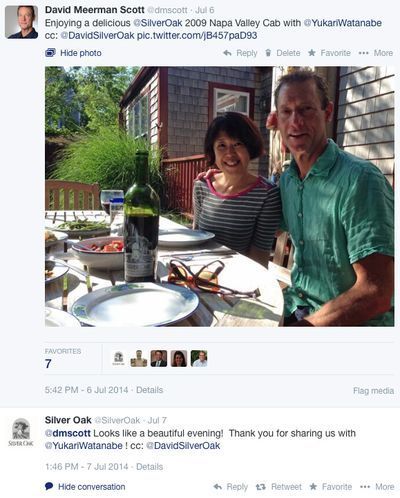 I saw this in action a few weeks ago, as I enjoyed a delicious bottle of 2009 Silver Oak with my wife @YukariWatanabe. When I tweeted the photo evidence, @SilverOak responded, unlike many brands that I try to engage with on social networks who don’t respond to me at all like, say, Ritz-Carlton Hotel Company.
I saw this in action a few weeks ago, as I enjoyed a delicious bottle of 2009 Silver Oak with my wife @YukariWatanabe. When I tweeted the photo evidence, @SilverOak responded, unlike many brands that I try to engage with on social networks who don’t respond to me at all like, say, Ritz-Carlton Hotel Company.
When I dug a little deeper by checking out the @SilverOak Twitter and Instagram feeds, Facebook page and YouTube channel, I noticed that Silver Oak isn’t just pimping products. Rather they authentically engage with people who are current or potential fans of the wine and who are enjoy interesting experiences with a bottle (or two).
Below is a little of my conversation with Duncan about how he encourages social engagement and also some background from Ian Leggat, director of marketing and public relations for Silver Oak.
Silver Oak Bottle Stories
“Mostly what people post is their experiences with the wine,” Duncan says. “I get to hear literally hundreds and hundreds of stories throughout the year about people getting engaged, people celebrating a birth, celebrating somebody’s life, or just having pizza on a Thursday night. We’re very fortunate that our business is to make a product that is used for special occasions, be it from the largest occasions in somebody’s life to something mundane but special, and we encourage people to share their experiences with our wine.”
Silver Oak is an expensive bottle, a bit under USD $100 and up depending on the vintage and where you buy it. What I’ve noticed about other high-end wines is the branding plays off a snobby appeal. Sometimes wineries play “hard to get” - making wines scarce to increase the perception of value. Silver Oak does the opposite. The wine is ready when you want it.
“We like to think of Silver Oak as wine for special occasions,” Duncan says. “It’s available. You can buy it at your retailer and you can buy it at the restaurant. It’s an expensive bottle of wine, but it’s not an out-of-reach bottle of wine. We treat culture really seriously like the culture of the Grateful Dead. We’ve done a lot of work with the winery to determine who we are, what it means, how it feels. Fortunately, our employees get it and I think it comes through in social media, particularly on Twitter and Facebook.
How Silver Oak grew on social media
In 2008, Duncan had an opportunity to entertain Jack and Suzy Welch at the winery. “We had a three-hour lunch and Jack just grilled me the whole time, like a second MBA. He asked things like: ‘How do you pay your salespeople? Who is on commission?’ And at the end of the lunch, Jack says: ‘What’s your Twitter handle. I will tweet that I was here.’ This is when Twitter was getting to be a big deal. I said: ‘I think it’s @silveroak.’ And Jack said ‘What? You’re not on Twitter? I have one million followers. This is the most important thing that’s going on right now. You need to be on this.’ That day we had six followers on Twitter. Jack Welch tweeted out that he had a fantastic lunch at Silver Oak and the next day we had 75 followers on Twitter. Then I went to our team, and I said: ‘You guys, we got a get on this!’ Since then, we’ve really focused on social. We’ve got as big a social media presence as any winery of any size, whoever you pick.”
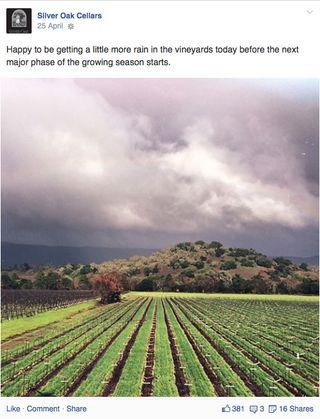 I like the way Silver Oak uses beautiful images to share on social media. There are frequent shots of the vineyard, buildings, and people who make the wine. It makes me want to visit the winery and try more of their wines!
I like the way Silver Oak uses beautiful images to share on social media. There are frequent shots of the vineyard, buildings, and people who make the wine. It makes me want to visit the winery and try more of their wines!
When I discuss companies engaging with customers on social networks, many CEOs push back and want to know about ROI. It’s a fear-based response to the unknown. Spending time doing this all sounds and feels nice to CEOs but many are reluctant to dive in. I asked Duncan about this because he went all out in social media after Jack Welch told him he needed to.
“I think it’s quite simple,” Duncan says. “In the wine business, if you’re paying somebody, say, $75,000 per year to be a social media manager and that means you’re engaging individually and having a conversation with 12,000 customers, that’s value. But how much does it cost to buy a full-page ad in Wine Spectator or the Robb Report? It costs $75,000 an issue! If you think about it in terms of your advertising budget, you can have real impact. I may not be able to tell you a direct rate of return to my bottom line, but I can tell you are sales are off the charts right now.”
Building social media into the company
“Social is important because it gives us a chance to listen,” says Ian Leggat, director of marketing and public relations at Silver Oak. “More than anything else, we look for social signals to get a temperature check on our brand and to understand what are followers are excited about.”
Partly because Silver Oak has been active on social networks for six years and partly because they use the channels to actually engage with customers rather than try to sell products, the company has build a strong presence.
“We have probably the most passionate fan base of any wine that I’m aware of and we cultivate evangelists through our social media channels and help celebrate them,” Leggat says. “Our strategy has evolved over the years to be less about pushing content out and more about facilitating dialogue in our social channels and reaching out to influencers and pulling them and to those conversations. What we really care about is not adding followers as much as the conversations that we have with them, and creating the kind of content that facilitates sharing.”
And people do share, based on the number of likes and shares on Facebook and people who engage with Silver Oak on Twitter.
“The Silver Oak brand is very much linked with special moments and all we are doing is facilitating people to share the special moments and be excited about them,” Leggat says. “Silver Oak is the wine that you drink to celebrate the birth of a child, to celebrate an anniversary and all we are really doing is creating an outlet for those stories to get told. Last fall we were developing our print newsletter, and we reached out on Twitter to get a couple of these bottle stories in 140 characters or less. Some of the things that came back to us were so powerful. We had one where someone had waited out Hurricane Sandy with a bottle of Silver Oak and a flashlight. That’s all she had. We had someone who ordered a large format bottle of Silver Oak in place of a wedding guestbook and just had people sign that bottle of Silver Oak and make this beautiful keepsake in their home. They wanted to take that picture and share with everybody. For us, it’s really just maximizing the social capital that we have among the very engaged base.”
August 4, 2014
Real-time lessons from the photo pit
 I had a blast this weekend at Gathering of the Vibes - excellent music with a crowd of friendly and laid back music fans at the best-organized festival I’ve been to.
I had a blast this weekend at Gathering of the Vibes - excellent music with a crowd of friendly and laid back music fans at the best-organized festival I’ve been to.
I spent a lot of time in the photo pit and got to thinking about how photography has changed over the years.
As I watched the pros shoot (and I joined in with some lame attempts of my own) I realized there are lessons from the photographers to those of us in the sales and marketing worlds.
I was especially intrigued by my discussion with Scott Harris who told me that he has a focus on real-time photography. Scott is a House Photographer at the historic Capitol Theater in Port Chester, NY and also photographs events at other NYC venues.
Real-time photography
Scott shoots with the typical big rig digital SLR camera and uses Wi-Fi to send the best images instantly to his smartphone. Then he quickly edits a photo and uploads it with a caption so music fans can see images of their favorite bands just one or two songs into the set.
The importance of real-time played out Saturday night (actually Sunday morning) at Vibes when music fans around the world were excited to see Grateful Dead drummers Mickey Hart and Billy Kreutzmann playing in their first announced gig with the Disco Biscuits. At about 1:00 am, they hit the stage and a soon photos were uploaded for people to see no matter where they are: at the gig, at home, in a bar, at another show.
 What a huge difference from film days. When people like my friend Jay Blakesberg got started in the pre-digital days, the necessity of processing film meant photos typically took days to appear.
What a huge difference from film days. When people like my friend Jay Blakesberg got started in the pre-digital days, the necessity of processing film meant photos typically took days to appear.
Some daily newspapers were able to run photos in reviews in the next day’s paper, but that meant the photographer had to hightail it back to the newspaper office from the venue after shooting a song or two to process film in time to make deadline.
While not real-time, I posted a few Gathering of the Vibes photos and videos to my Instagram, Vine, and Twitter accounts, but I usually wait until the next morning so I can enjoy the music rather than fiddle with technology.
Real-time has changed every business
Think about the difference between running back to the news bureau to process black & white film in order to make a print newspaper publishing deadline compared to shooting, editing, and uploading a high quality color image before the first song even finishes.
Those same dynamics are at work in your business. Real-time has changed every business (including yours).
Gathering of the Vibes photos 1) Edward Sharpe and the Magnetic Zeros lead vocalist Alex Ebert attracting long lenses 2) Jay Blakesberg in the pit and 3) Grateful Dead drummers Mickey Hart and Billy Kreutzmann playing with the Disco Biscuits all by David Meerman Scott at Gathering of the Vibes 2014.
July 30, 2014
Why I Totally Hate Google Hangouts!
Google Hangouts on Air make me feel stupid.
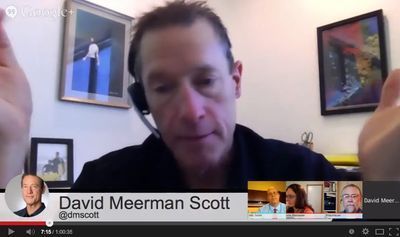 I’ve agreed to do about 20 interviews via Google Hangouts on Air and every time I’ve tried to log onto one, there has been a problem.
I’ve agreed to do about 20 interviews via Google Hangouts on Air and every time I’ve tried to log onto one, there has been a problem.
My technology failure makes me look dim-witted I don’t like that feeling one bit.
In most cases, the problem is probably user error.
Yep, I freely admit my failure to log in quickly is likely due to ineptitude. But in my defense, I’ve been able to master a lot of technologies, so I’d like to think there’s something that’s not intuitive enough with Google Hangouts for a dummy like me to handle.
The promise of Google Hangouts on Air is exciting.
I like the idea of Hangouts and I agree to them because it seems so straightforward: Somebody invites me for a quick video interview and for free we hang for 15 minutes or so with a live audience. The resulting video is then uploaded to YouTube like this one: Read Science! Episode 23 : "Marketing the Moon" Edition. Simple, right?
Except that, for me at least, it is too difficult to log onto a Hangout.
I feel exactly like I did in fifth grade when I was always picked next to last for teams in gym class. I suck and it is embarrassing.
I was so late logging in when I spoke with Stephenie Rodriguez in Australia via Hangout that her live audience gave up waiting and left. Ugh.
My inability to log in has gotten so embarrassing that I now ask to do a Skype video call instead. It that’s not possible, I insist that the person interviewing me call me on the good old telephone 10 minutes early and help me log onto Google Hangouts. (How lame is that?)
But still, in today's world, technology shouldn't be so difficult, right?!
I’m not on Google Island 24x7.
The only explanation I can think of other than me having some sort of weird mental block with Hangout technology is that I do not live in Google full time like many people do.
Yes, I have a Google Plus at +David Meerman Scott. However, my primary email is not a Gmail account. So when I’m invited to a Google Hangout, the invite comes via my email, which is not in synch with my G+ so when I log in via G+ there is no invite.
That’s my excuse and I’m sticking to it!
Am I the only idiot here? (Be honest).
July 28, 2014
Upgrade to Canada #social program nabs tourists from other countries
 Last month I presented at an event in Winnipeg, Canada for Travel Manitoba. The travel market is crowded and consumers have lots of places to find information about places to visit. Into this environment, the best content can win the day.
Last month I presented at an event in Winnipeg, Canada for Travel Manitoba. The travel market is crowded and consumers have lots of places to find information about places to visit. Into this environment, the best content can win the day.
I had an opportunity to speak with Siobhan Chretien from the Canadian Tourism Commission to learn about a terrific social experiment they conducted.
Upgrade to Canada involved intercepting travelers at the Frankfurt and Lyon airports and persuading people to switch their holiday plans on the spot to visit Canada instead. People only had a few minutes to consider the offer.
Direct link to the video on YouTube about the Upgrade to Canada social program.
Real-time approach drives interest
Fortunately, there were many people who were open to the serendipity of a change and they spontaneously changed their travel destinations.
Canada Tourism then created real-time content around the travelers and their experience, and the tourists themselves eagerly shared on social networks.
“The results were extraordinary,” Chretien told me. “Not only were we able to share first-hand the travelers stories with the world, but online we received further upgrades from over 100 countries by travelers who switched to Canada.” Social networking and mainstream media drove awareness of Canada as a destination and Canada’s share amongst competitive destinations increased by a remarkable 21.5%.
I love the idea of requiring people to make a decision in just a few minutes. The real-time nature of how people then share their experience separates “Upgrade to Canada” from other social media campaigns from tourism organizations.
Marketing a national brand
“Marketing a national brand from a tourism perspective is exciting and requires passion,” Chretien says. “However, no matter how sexy a destination is, promoting a country for tourism purposes has its challenges, especially with the world now being a smaller place with many travel options and competing experiences and destinations. The traveler of today and of the future has a vast array of options. It is not enough to run slick ad campaigns or hope that price alone will drive a sale and convert a tourist. The traveler needs to be inspired, motivated, influenced and in some cases convinced on the spot that the time is now to make the trip!”
How people’s travel decisions are influenced by their social connections
Unlike booking travel 20 years ago, consumers are in charge of the buying process. They have huge amounts of information available from countries, regions, hotels, airlines, and outfitters plus independent reviews from sites like Trip Advisor.
Smart organizations understand this new world and build a buying process around the realities of independent research. Instead of generic information dreamed up by an advertising agency, they tell authentic stories that interest their customers. Instead of selling, they educate through online content. Instead of ignoring those who have already made a purchase, they deliver information at precisely the moment customers need it.
“Canada, not unlike hundreds of countries, is often viewed as an ‘I will go there one day' place,” Chretien says. “This is a chronic concern for travel brands when trying to complete a sale, as the tipping point is not always clear as to how to compel the traveler to make that final decision over another place to vacation. The one thing that is clear: We are all ‘influenced’ in our travel decisions. Sometimes it is by way of media. Most often it is from a respected source, a friend, family member or user generated and relevant content. With so much media distracting our target travelers in their daily activities, we needed to come up with a means to command attention through channels that would reach the consumer and compel them to travel now!”
July 24, 2014
The Health Club That Tells Its Story by Exercising an Attitude
I’ve been a member of health clubs in four cities where I’ve lived: New York, Tokyo, Hong Kong, and now in the Boston suburbs. In each location, my decision to join a club was spontaneous. I’d think, “Oh, shoot. It’s mid-December and my New Year’s resolution is to get fit, so I need to join a gym.” (That’s exactly what happened when I lived in New York City.) Or several years ago when I decided to swim a day or two per week to keep in shape for surfing, I decided to join a club with an indoor pool. I used social media to ask my friends who live in the Boston area about the club they belonged to. I also hightailed it to Google to see what clubs were nearby. And inevitably, like so often when I am in the market to buy a product, I’d start to notice advertisements for health clubs in the Boston Globe.
I made a quick decision join Boston Sports Clubs because I just loved the cheeky personality that came through in their online and offline strategies to reach me! They got my attention in a big way even before I walked in to my local club. When I did visit for the first time, the unconventional, humorous approach of the company story continued as I saw posters in the lobby.
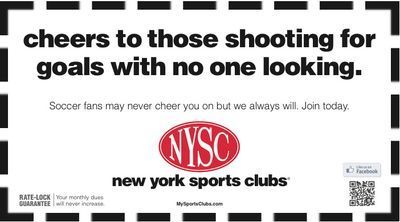 That’s exactly the strategy the parent company has used to become the largest operator of health clubs in the northeastern United States.
That’s exactly the strategy the parent company has used to become the largest operator of health clubs in the northeastern United States.
An organizational story comes from the top
“When you think about joining a gym, it’s because something in your life changes and causes you to come in,” says Robert Giardina, CEO of Town Sports International, the owner and operator of New York Sports Clubs, Boston Sports Clubs, Washington Sports Clubs, and Philadelphia Sports Clubs. “You could come in because of a health reason. It might be a reunion or a wedding. At that point you’re going to say, ‘I need to join a gym—which gym do I want to belong to?’ And that gym’s personality has to fit who you are. You start by thinking about which gyms you know that are in your market. And that’s the moment that people think of us.”
The personality that Giardina has built and maintained for the branded clubs in each city—New York, Boston, Washington, and Philadelphia—is one of playfulness. “Sports clubs have always been about price and hard bodies,” he says. “Clubs say, ‘Let’s get a price out there, let’s see if we have images of a hard body or some weights, and we sell what we sell.’ We did that for a while and, first, it really never set us apart, and second, it really just didn’t create any conversation.”
Growing from a small health club operator to 150 clubs with half a million members
Giardina has been in the fitness business for his entire career. He joined the company that was to become Town Sports International in 1981 (initially selling squash memberships) and moved up to chief operating officer in 1992. In 2002 he became CEO, expanding the business to over 150 clubs with 500,000 members and taking the company public in 2006.
About 20 years ago, Giardina looked at the market and realized that all of the gyms looked the same. They all sold in the same way, and they all positioned themselves the same way. “We liked the product that we offered and we liked the services that we offered, but we really had to create a difference,” he recalls. “People knew what a gym was. The challenge that we faced was to break through the clutter and get people talking about us.”
At that time, Giardina spoke with a bunch of branding and advertising agencies, but none of the big ones showed him anything that would get him noticed. He did hear from one person who truly captured the challenge, so he began working with CJ Waldman of the tiny Octopus Creative Group, and they’ve been together ever since. Giardina recalls, “CJ said, ‘You’ve got to do things that are going to make you a little bit uncomfortable because that’s what will get people talking about you.’” They worked together to craft a story that resonates to this day with buyers. It’s one that drips with conflict and uses humor in an interesting way.
One of the first stories that ran in the late 1990s played off a typical health club message that depicts people with good bodies presenting themselves attractively in the dating market. It was run just prior to Valentine’s Day with copy that said: “This could be the year you’ll find your perfect soul mate who will love you for who you are and physical appearance will mean nothing.” And then in small type at the bottom, it said in parentheses: “And the tooth fairy could introduce you.” “We ran the ad and all these people started talking about it,” Giardina says.
When the New York Sports Clubs run such an advertisement in the local metropolitan newspapers, the narrative campaign is supported through window displays as well as on posters inside the clubs. The same promotional strategy is used in Boston, Washington, and Philadelphia Sports Clubs, too. Sometimes, the stories appear in unlikely places like bus shelters. The strategy ensures that existing members like me feel good about our choice of a fun-loving health club, and believe me, it gets us to talk up the club! And that means the stories do a great job attracting people who are thinking of joining a gym at that moment.
When Reebok entered the New York market and started advertising its new large health club, Giardina had an opportunity to poke fun at the new competitor: “Reebok’s opening a gym. Maybe New York Sports Clubs should make sneakers.”
Newsjacking famous personalities in the news
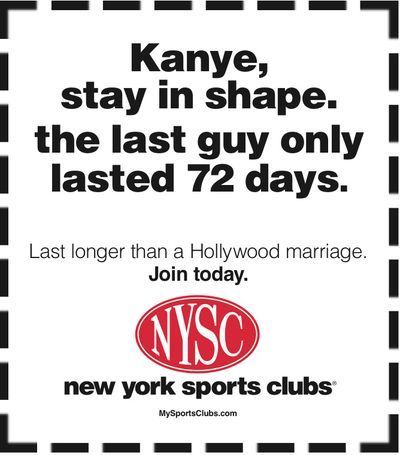 As the clubs started to develop strong personalities, Waldman and Giardina began to poke lighthearted fun at celebrities in the news, including, over the years, Bill Clinton, Anthony Weiner, and Alex Rodriguez.
As the clubs started to develop strong personalities, Waldman and Giardina began to poke lighthearted fun at celebrities in the news, including, over the years, Bill Clinton, Anthony Weiner, and Alex Rodriguez.
Giardina himself is personally involved in creation of the stories. Some of the famous people who hit the news that Town Sports International clubs riffed off in recent years include:
Chris Christie: “Don’t worry, Chris, our members stop traffic too.”
Miley Cyrus: “Miley, better to work out than twerk out.”
Charlie Sheen: “Charlie, we can’t offer $3 million per episode, but we can give you March for free.”
And my favorite: “Kim Jong-un, with a great bod, you don’t need a big missile.”
They time their newsjacking to run when the celebrity is in the news.
Giardina’s approach to storytelling gets more attention because so many people talk about the latest story on social networks. In addition, the mainstream media loves to cover stories about how the clubs’ talked-about marketing skewers well-known people. “The clever, a little bit edgy ones about the celebrities will end up on a local newscast,” he says. “You’ll also see them on Entertainment Tonight and CNN and lots of other places. We could never pay for that kind of coverage.”
The CEO is the chief storyteller
Unlike most CEOs who delegate storytelling to the marketing staff, Giardina himself is involved in all aspects of the way in which the clubs communicate. He personally chooses and approves the stories focused on celebrity, and that personal attention from the leader of the company over 20 years has been instrumental in making Town Sports International the success that it is today, growing from a handful of locations to more than 150.
When Waldman and Giardina work, they get as edgy as possible—it’s an important aspect of the company brand. “CJ pushes me as far as he can, right to the line of acceptability,” Giardina says. “A few times we might have gone too far, like years ago when Bill Clinton was president and we were opening up clubs everywhere. We said: ‘New York Sports Clubs have more openings than Clinton’s zipper.’ We’re always thinking about breaking through the clutter.”
I asked Waldman about writing the ads: “I always think that if this didn't work out for me I could be a New York Post headline writer,” he says. “I'm envious of those guys because I've been doing for so long it's like literally seconds that I can come up with something. I'm constantly scanning the news last second so we can be timely because sometimes we write things and then by the time the media is going to run it's not going to be relevant.”
A great story builds business.
Over time, the clubs have established a great reputation for their communications approach, and that has carried through to how people think of the clubs. In the same way that I did when I was choosing a club, people remember the fun-loving chain of health clubs, and many want to be a part of that. Giardina says, “If you talk to people who know us, and you ask, ‘What comes to mind when you think of Boston Sports Clubs or New York Sports Clubs?,’ the first thing that usually comes out of their mouths is, ‘Oh yeah, I love their advertising.’ People know us but we don’t spend that much. We spend less than almost anyone in the industry. But our personality makes people say, ‘Let me go see who they are. They’re in my neighborhood. I want to see what kind of club they have.’”
Just like the sports clubs that Giardina runs, your organization needs compelling stories about what you deliver, and those stories need to be cleverly told. When this is done well, people will talk about you in social networks, and the mainstream media will want to write about you in newspapers and magazines, and broadcast about you on radio and television.




